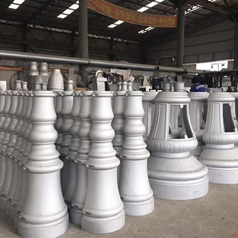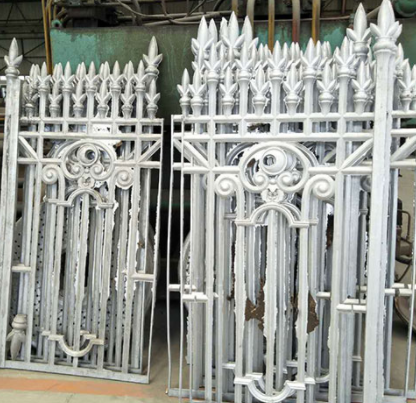Complex aluminum casting is a new technology, which is based on electromagnetic pump low-pressure casting technology, aluminum smelting and forming compound purification technology and manufacturing core, to produce high-quality aluminum casting modern technology. Electromagnetic pump low-pressure casting metal liquid transfer system has a stable flow, flow control is convenient, ease the process of molten alumina suction and easy to achieve the advantages of using the process automation, which not only improves the casting quality of aluminum casting, but also can improve the working environment. Reduce labor intensity, achieve automation and modern casting production.
Aluminum Furniture Part
Purification of molten enamel alloy castings is an important part of the aluminum smelting and composite purification facilities in addition to aeration and spin foam ceramic filters with high degassing performance, except for metal inclusions. In addition, it USES a new long-life lining material, with an independent insulation/heating system that can be used for mass continuous production, but also for batch production. This technology has high efficiency, long service life, low cost and effective, easy to install, use and flexibility. There are three main aspects to be considered in solving complex problems of quality aluminum casting:
(1) melting and melting of liquid aluminum;
(2) smooth transition aluminum metal halide lamp,
(3) size and stability of the mold and sand core process.
Much of the expense of aluminum permanent mold casting is the machining and shaping of the mold, which is normally made from gray iron or steel. The mold is shaped into the geometric shape of the designed part with the specifications and shape of the part divided into two halves. In the injection process, the halves of the mold are tightly sealed such that no air or contaminants are present. The mold is heated prior to the pouring of the molten aluminum, which can be ladled or injected.
At the completion of the process, the mold is allowed to cool to allow the aluminum part to solidify. Once cooled, the part is rapidly removed from the mold to prevent the formation of defects.
Regardless of how simple the process may seem, it is a scientifically and technically engineered method for producing high volume parts.
The sand casting process involves packing sand around a reusable pattern that has the shape, details, and configuration of the final product. Included in the pattern are risers that allow the molten metal to be poured into the mold. The dimensions of the pattern are slightly larger than the product to account for shrinkage during the cooling process. The sand has the weight and strength to maintain the shape of the pattern and is resistant to interacting with the molten metal.
Die casting is a process where molten aluminum is forced under pressure into the mold. The products produced are exceptionally accurate and require minimal finishing or machining. The process of die casting is rapid, which makes it ideal for mass production of high volume parts.
The two forms of die casting are hot and cold. The difference between them is related to how the molten metal is injected into the mold. In hot die casting, the hot chamber is connected to the melting pot and uses a plunger to force the molten metal through a gooseneck into the mold. In cold die casting, the melting pot is not attached to the die casting system, and the molten melt is ladled into the cold chamber where it is forced by a plunger into the mold.
Aluminum Casting Fence
Vacuum die casting is directly related to pressure die casting with the difference between the processes being the use of a vacuum instead of pressure. The molten metal is placed in the shot chamber by a plunger or ladle.
The die is enclosed in an airtight housing that has two openings, a sprue at the bottom and a vacuum outlet at the top. The sprue is placed below the surface of the molten metal. A vacuum is created in the receiver, which creates a pressure differential that causes the molten metal to flow up the sprue and into the die.
Investment casting, also known as lost wax casting, begins with wax being injected into the die to create the pattern of the finished product. The waxed patterns are attached to a sprue to form a tree-like configuration. The tree is dipped into a slurry multiple times, which forms a strong ceramic shell around the wax shape.
Once the ceramic has set and hardened, it is heated in an autoclave to complete the dewax burnout. To achieve desirable temperature of the shell, it is pre-heated before being filled with the molten aluminum, which is poured into the sprue and passes through the series of runner and gates into the molds. When the parts harden, the ceramic is knocked off leaving the tree connected parts to be cut from the tree.
The lost foam casting process is another type of investment casting where wax is replaced with polystyrene foam. The pattern is molded from polystyrene in a cluster assembly like the runner and sprues of investment casting. Polystyrene beads are injected into heated aluminum molds at low pressure with steam added to expand the polystyrene to fill the cavities.
The pattern is placed in densely packed dry sand that is vibration compacted to eliminate voids or air pockets. As the molten aluminum is poured into the sand mold, the foam is burned off, and the casting is formed.
We are an Aluminum Casting Decoration manufacturer. If you are interested in our products, please contact us now!
 How To Solve The Burr Of Aluminum Castings
Jul. 29, 2024
How To Solve The Burr Of Aluminum Castings
Jul. 29, 2024
 Aluminum Casting 4 Kinds Of The Surface Treatment Pr...
Jul. 09, 2024
Aluminum Casting 4 Kinds Of The Surface Treatment Pr...
Jul. 09, 2024
Copyright © Dalian Lianjiang Metal Co., Ltd. All Rights Reserved | Sitemap
Recommend Products: Aluminum Mailbox With Post
